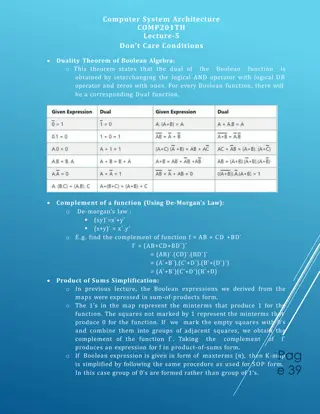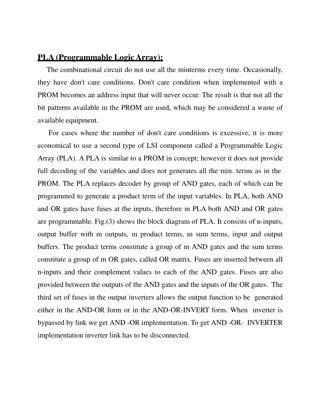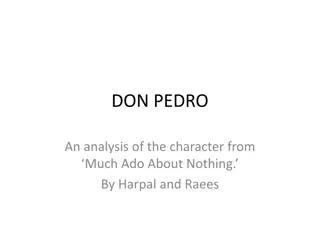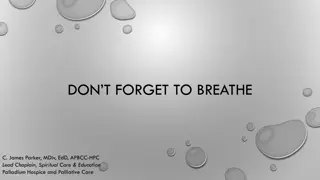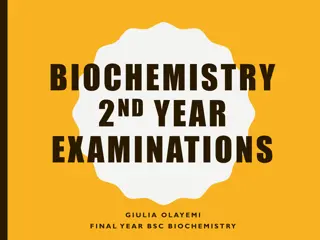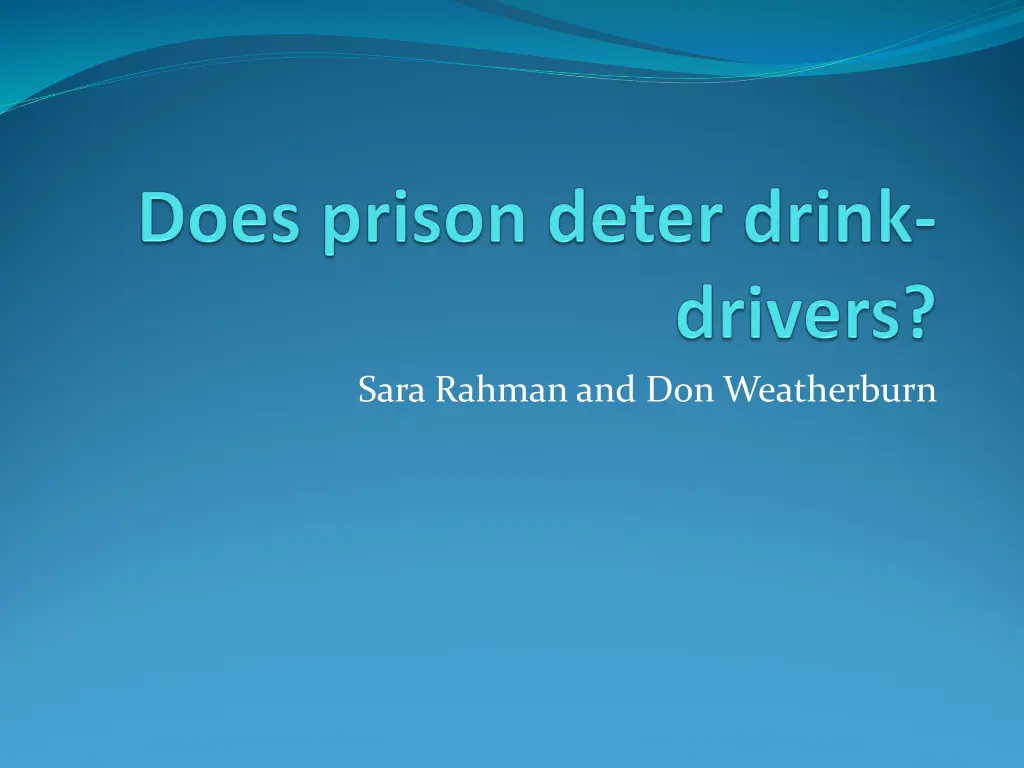
Understanding the Impact of Prison on Recidivism in Drink Driving Cases
Explore the effects of prison on drink driving recidivism, considering factors like penalty severity and recidivism rates. Discuss possible solutions, such as instrumental variables and 2SLS analysis, to address biased estimations. Utilize the current study to examine the relationship between prison and recidivism, emphasizing the importance of controls and sentencing disparities.
Download Presentation

Please find below an Image/Link to download the presentation.
The content on the website is provided AS IS for your information and personal use only. It may not be sold, licensed, or shared on other websites without obtaining consent from the author. If you encounter any issues during the download, it is possible that the publisher has removed the file from their server.
You are allowed to download the files provided on this website for personal or commercial use, subject to the condition that they are used lawfully. All files are the property of their respective owners.
The content on the website is provided AS IS for your information and personal use only. It may not be sold, licensed, or shared on other websites without obtaining consent from the author.
E N D
Presentation Transcript
Background Sanctions for drink driving have become tougher Average fines have increased The percentage imprisoned has increased
Prison is expensive Number going to prison each year = 180 Average length of stay = 6 months Cost per day in prison =$180 Annual cost = approx. $6 million Growing proportion are Indigenous But does prison work?
Past research Nagin, Cullen & Jonson (2009) Compared with noncustodial sanctions, incarceration appears to have a null or mildly criminogenic effect on future criminal behaviour Villettaz, Gillieron & Killias (2015) No significant difference is found in the meta-analysis between four controlled and one natural experiment Helland, E. & Tabarrok, A. (2007) California s three-strike legislation reduces felony arrest rates by 17-20 per cent But no research on prison and drink-driving!
The major challenge Recidivist offenders more likely to receive a prison sentence In other words, penalty severity (S) is endogenous Penalty severity (S) Recidivism (R) If we estimate: ? = + 1? + 2? + Our estimate of 1will be biased and inconsistent
Solution Find a factor (instrumental variable) I that influences S but which has no effect on R except through S Conduct a 2SLS analysis Stage 1: Regress the likelihood of prison against a vector of controls and the instrument Stage 2: Include the predicted likelihood of prison obtained in stage 1 among the controls in stage 2 Now by construction the variable measuring penalty severity is purged of its association with factors affecting reoffending
The current study Examines the effect of prison on drink-drive (DD) recidivism Includes a large range of controls Exploits disparity in sentencing as an instrument
Comparison group Suspended sentence Must impose a prison sentence before deciding to suspend it Enhances the likelihood that those who get prison are similar to those who get a suspended sentence
Dependent variables Whether convicted of another drink-drive offence within 24 months free time Whether convicted of another drink-drive offence within five years free time Whether convicted of any offence within 24 months free time
Data Source: The NSW Bureau of Crime Statistics and Research re- offending database ( ROD ) Study samples 7,335 offenders imprisoned for DD 3,946 offenders given a suspended sentence for DD
Analysis Two stage least squares ??= ?0+ ?1??+ ?? + ? + ? ??= ?0+ ?1 ??+ ?? + ? + ? Where: ?? = probability individual i will be imprisoned ?? = probability individual i will reoffend ?? = estimated probability individual i will be imprisoned (from equation 1) Zi = dummy variable where 1 if prison and 0 if suspended sentence X is a vector of controls ? = court fixed effects ? = month/year fixed effects
Controls Age Gender Indigenous status Socioeconomic status Whether legally represented No. of concurrent offences No. prior court appearances Whether received prior fine Whether received prior licence disqualification Whether convicted of a prior traffic offence Whether convicted of a prior justice procedure offence PCA range at index contact Whether previously imprisoned Whether previously convicted of a violent offence
Constructing the instrument We calculate two measures for each magistrate: 1. ??= the proportion of all cases unrelated to the person the magistrate is dealing with, where he or she has imposed a prison sentence 2. The average residual (r) in prison sentencing for a magistrate in all cases unrelated to the person they are dealing with, where r is the variation remaining after estimating P?= ?? + ?? + r In words, r is the leftover variation in the likelihood of prison after controlling for all other observed possible influences on the likelihood of imprisonment
Do we have a suitable IV? Exclusion restriction Randomness Relevance Monotonicity
Exclusion restriction The IV must not affect the outcome except through its correlation with treatment Response:Can t prove this but: Allocation of cases to magistrates is not based on characteristics of the offender or offence Magistrates are allocated to courts and must take all cases listed in that court for that day
(Quasi-) randomness The IV should be quasi-random, i.e. it should not differ based on the unit s characteristics Test for randomness: Regress IV on all observed characteristics and conduct a joint F-test of the explanatory variables If the variables do not jointly determine IV then the IV can be considered quasi-random F-statistic (unresidualised) = 1.07 (p = 0.37) F-statistic (residualised) = 1.32 (p = 0.14)
Relevance The IV must strongly affect the likelihood of treatment The common test is that the partial F-test of the first stage equation should exceed ten (10)
Relevance Sample 1: Prison vs. suspended sentences Partial F-statistic Outcome: PCA offence in 24 months free time 271.22 2SLS (Unresidualised) 188.50 2SLS (Residualised) Outcome: PCA offence in 5 years free time 271.22 2SLS (Unresidualised) 188.50 2SLS (Residualised) Outcome: Any re-offence in 24 months free time 269.03 2SLS (Unresidualised) 185.97 2SLS (Residualised)
Monotonicity The IV must significantly affect treatment in the same direction for all subgroups or not be significantly different from zero 34/40 groups have a positive and significant effect (remainder non-significant)
Suspended sentence Variable Variable value Prison 17-22 400 (5.5%) 165 (4.2%) Age group 23-29 30-34 35+ Female Male 1229 (16.8%) 997 (13.6%) 4708 (64.2%) 1100 (15.0%) 6235 (85.0%) 521 (11.0%) 4198 (89.0%) 3711 (53.6%) 3211 (46.4%) 976 (14.1%) 1716 (24.8%) 2231 (32.3%) 1994 (28.8%) 856 (12.1%) 6197 (87.9%) 4176 (56.9%) 1866 (25.4%) 1293 (17.6%) 1042 (14.2%) 1452 (19.8%) 1362 (18.6%) 945 (12.9%) 2534 (34.5%) 576 (14.6%) 590 (15.0%) 2614 (66.3%) 235 (6.0%) 3711 (94.0%) 563 (19.8%) 2285 (80.2%) 1616 (47.1%) 1818 (52.9%) 319 (9.3%) 799 (23.3%) 1076 (31.4%) 1236 (36.0%) 322 (8.5%) 3445 (91.5%) 1223 (31.0%) 1317 (33.4%) 1406 (35.6%) 261 (6.6%) 431 (10.9%) 523 (13.3%) 462 (11.7%) 2269 (57.5%) Sex/Gender Indigenous Non-Indigenous Major cities Indigenous Status Area Inner regional, outer regional and remote Highly advantaged Advantaged Disadvantaged Highly disadvantaged Socio-economic disadvantage of postcode No Yes Legal representation 1 Number of concurrent offences 2 3+ 0 Number of prior court appearances 1 2 3 4+
Suspended sentence Variable Variable value Prison No 3652 (49.8%) 1425 (36.1%) Prior penalties - fine Yes 3683 (50.2%) 2521 (63.9%) No 3847 (52.4%) 1427 (36.2%) Prior penalties - licence disqualification Yes 3488 (47.6%) 2519 (63.8%) No 3658 (49.9%) 1314 (33.3%) Prior offences - traffic Yes 3677 (50.1%) 2632 (66.7%) No 6487 (88.4%) 2695 (68.3%) Prior offences - driving Yes 848 (11.6%) 1251 (31.7%) No 6208 (84.6%) 2784 (70.6%) Prior offences - justice procedures Yes 1127 (15.4%) 1162 (29.4%) High 5072 (69.1%) 2673 (67.7%) PCA range at index Medium 2263 (30.9%) 1273 (32.3%) No 6355 (86.6%) 2373 (60.1%) Prior penalties - imprisonment Yes 980 (13.4%) 1573 (39.9%) No 6082 (82.9%) 2835 (71.8%) Prior offences - violence Yes 1253 (17.1%) 1111 (28.2%)
Results p- Prison vs. suspended sentences Coeff. (prison) value Outcome: PCA offence in 24 months free time 0.01 -0.01 -0.01 .263 .636 .601 OLS 2SLS (Unresidualised) 2SLS (Residualised) Outcome: PCA offence in 5 years free time 0.02 -0.01 -0.01 .113 .636 .601 OLS 2SLS (Unresidualised) 2SLS (Residualised) Outcome: Any re-offence in 24 months free time -0.01 .255 OLS -0.12 -0.13 .021 0.026 2SLS (Unresidualised) 2SLS (Residualised)
Conclusion Not much evidence that prison is a specific deterrent to drink-driving But some evidence of a specific deterrent effect??? DD result not surprising Low risk of apprehension/given offending Low risk of imprisonment/given apprehension Most offenders quit after their first conviction Better off blocking the opportunities for drink-driving E.G. Ignition interlocks










